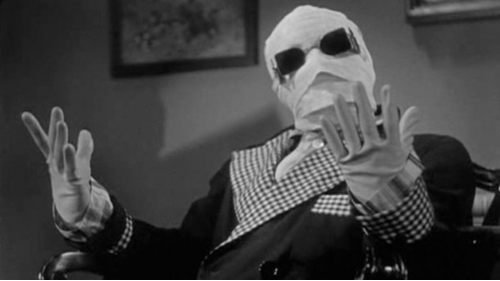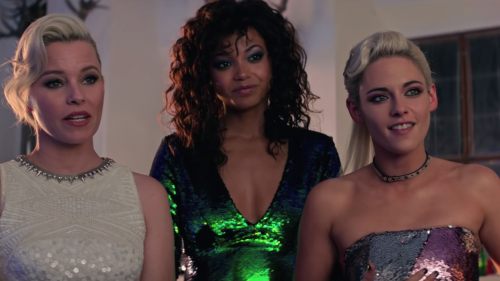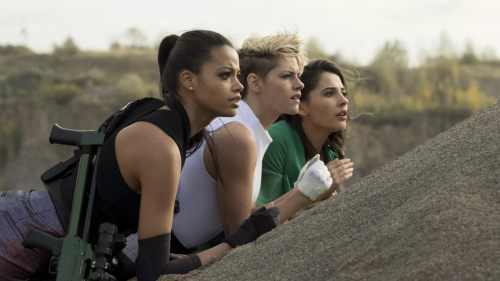POWER RANGERS Review: It’s Mopin’ Time!
Well, it’s come to this. Power Rangers. Excuse me, it’s officially titled Saban’s Power Rangers — in case you get this third cinematic adaptation of the long-running series mixed up with the various other non-canon, unlicensed power rangers floating around the bargain bin of your local convenience store toy aisle. Like Lee Daniels’ The Butler before it, the title allows us to never forget who the true auteur is.
In this case, it’s Haim Saban, the wealthy media mogul who first adapted the Japanese Super Sentai series into the laboriously titled Mighty Morphin Power Rangers series for the American TV market. Saban turned modest fight footage from Super Sentai into a brightly colored, campy punch-fest for Saturday morning consumption and became even richer than he was before. He was so dedicated to the franchise that he bought back the rights from Disney in 2010, aiming to produce the lavishly budgeted feature reboot that comes out this Friday — a film so dreary, so self-important, and so derivative that an hour into the film, I considered drowning myself in scalding hot butter.
Directed by Dean Israelite, Power Rangers aims to update Saban’s Xeroxed brain child for modern audiences. A Vancouver fishing town stands in as Angel Grove, which lends itself to the moody, misty cinematography. Watching the film, I couldn’t help but feel perpetually damp as the narrative takes Jason, Billy, Trini, Kimberly, and Zack from mopey teens to mopey superheroes. Bryan Cranston and Elizabeth Banks fill in as the wise Zordon and nefarious Rita Repulsa respectively. Over $100 million was spent to revive a series that was best known for its low costs and massive merchandising profits, but a bigger budget doesn’t necessarily make a property like this better.
Time has not been kind to the second-hand source material for Power Rangers. The original series, broadcast on the Fox network, is the live-action equivalent of a Road Runner cartoon. The basic premise is the same every week. Rita devises a plan to defeat the Power Rangers and creates a monster to carry out her plan. She sends Goldar and a few of her Putty army to fight the Rangers (who may or may not be preparing for a biology exam or avoiding the comic hijinks of inept bullies Bulk and Scull) out of costume. The monster comes, the Rangers morph into their costumes, Rita makes the monster gigantic in order to squash the good guys, the Rangers get in their robotic Zords, and when all seems lost, they join to form the MegaZord. They vanquish the monster, then hopefully go finish their homework or pop some zits or something.
Not only did the formula make it easy to crank out English-language story scenes to match the existing Japanese monster brawls, it also fed into the idea that kids love nothing more than rote familiarity. This theory is best illustrated by the America’s Funniest Home Videos recurring trope of a harried father being struck in the genitals, an image which reminds me to get back to talking about the Power Rangers movie.
How does one make a feature-length film about five stereotypes fighting men in rubber suits? The first entry in the series, 1995’s Mighty Morphin Power Rangers: The Movie, was content to adapt the TV series’ earnest, Cub Scout style. The original cast was so generic that the first set of actors (save for David Yost as Billy) was replaced by the time the film came out and nary a protest was filed. They were “the nerdy one,” “the cool one,” “the black one,” “the Asian one,” and “the girl.” The villains wanted to take over the world. Why? Because they’re evil and evil characters do evil things. The budget went up, the writers made a valiant attempt to develop a coherent mythology for the universe, and they shot a completely gratuitous scene of the Rangers skydiving to the strains of the Red Hot Chili Peppers’ “Higher Ground.” The licensing rights for that song probably cost more than a single episode of Mighty Morphin Power Rangers.
Say what you please about the dubious charms of the original film, but the filmmakers were keenly aware of what they were adapting — a well-oiled assembly line for toys. This is not to say that selling baubles related to a TV series or movie is abhorrent. The mountain of Star Trek merch in my office would beg to differ. On some level, all genre entertainment is designed for that kind of secondary exploitation. It’s just that Power Rangers never had much going for it besides that. Franchises like Star Trek, Star Wars, Batman, Spider-Man, and others, have benefitted from well-rounded characters that, through decades of well-respected writers tinkering with them, took on mythic proportions. The toys are just gravy.
The script for Power Rangers, credited solely to Oscar-nominated screenwriter John Gatins (with a story credit going to four totally different people) gamely attempts to graft meaning onto Haim Saban’s cash cow. Jason is now a high school quarterback sidelined by injury and seeking a greater purpose to his life. Kimberly is a disgraced cheerleader. Zack’s a creepy loner who hangs out in the woods howling for no good reason. Zack is so weird that he spend a fair amount of the film’s runtime screaming to anyone that will listen that he’s “crazy.” I think the Ranger doth protest too much.
Also, Billy has Asperger’s, which explains the character’s aptitude with all manner of scientific dilemma. Trini comes out to her new friends as a lesbian and reveals that it's ostracizing her from her family. Instead of the TV series, where the Rangers were squeaky-clean overachievers (the original cast was written off by revealing that the missing characters had gone to Geneva to attend something called the “World Peace Conference”) the heroes are outcasts and misfits. It’s a trope that worked perfectly in 2009’s Star Trek, in which writers Roberto Orci and Alex Kurtzman made straight-arrow James T. Kirk a drunk college dropout.
Here, it fails miserably, primarily because Dacre Montgomery — the Australian newcomer tasked with making team leader Jason someone more than a teenager with a curious penchant for the color red — isn’t the charismatic screen presence we find with Chris Pine. Montgomery goes through much of the movie barking characters’ full names, as if he was mandated to do so in order to prevent audience confusion. When he’s supposed to be charming, he comes off as studied and wooden.
The only Ranger who makes much of an impression is RJ Cyler as Billy. Cyler, first seen in Me and Earl and the Dying Girl, lends a much-needed twitchy energy to the po-faced profundity and will probably be the one actor to escape this franchise unscathed. It’s never a good sign when your movie’s best performance belongs to a guy voicing a floating CGI head. This is yet another conspicuous movie cameo from Bryan Cranston, after his 10 minutes of screen time in the last Godzilla film. He pops up long enough to imbue the picture with some class, and then he vanishes. At this rate, he’ll be the new Michael Caine — making this Cranston’s version of Beyond the Poseidon Adventure.
Then there’s Banks’ Rita — alternatingly haunting and ridiculous, she’s in a different movie altogether. Rita appears first as a ghastly corpse, then a demented variation on Daryl Hannah’s mermaid from Splash, and finally, the gold-plated vamp you’d expect based on the trailers. It’s the strangest part of the movie, yet also the most appealing. She’s equally comfortable as a grungy sea demon and the approximation of Barbara Goodson’s memorable dubbed performance of Rita in the Americanized TV series. If only her work was in service of a film that had anything resembling a personality.
Instead, the minds behind Power Rangers were clearly influenced by every other successful reboot in the last 10 years, especially Star Trek, and that film’s ability to add gravitas and hipness to a franchise general audience equated with low production values and hammy acting. In fact, besides Star Trek, there’s a hint of the Marvel Cinematic Universe’s love of meta-humor, the tortured gloom of Twilight, and the naturalistic cinematography and teen dramedy/superhero mash-ups of Chronicle.
What else would you do with a 20-year-old TV series that didn’t have much of anything to say besides “go to school and be loyal to your friends” but cram as many stylistic references to successful films as possible? It’s a market-tested chemistry experiment of a movie, with just enough references to the source material to satisfy hardcore fans. You get the song, the Zords, the Putties, Goldar, and a litany of other references to the TV show. If fealty to the source is enough for you, you’ll find Power Rangers to be a satisfying film. You can cheer or chuckle when the thing you remember from childhood is given a pricey facelift. For the rest of us, Power Rangers offers a tedious origin story that wipes out the unintentional comedy and cheap thrills that made the series so popular two decades ago. Inadvertently, Haim Saban made the perfect updated version of Mighty Morphin Power Rangers — a copy of a copy of a copy.



